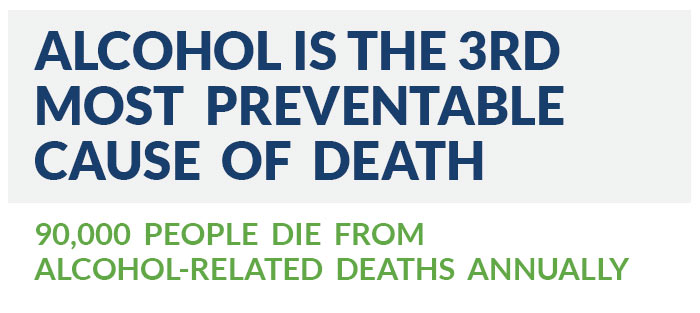HEALTH EFFECTS ASSOCIATED WITH COCAINE
When used in both powdered and freebase varieties, cocaine typically produces a markedly intense high. This temporary, desirable state is associated with increased mental alertness and euphoria; however, a litany of adverse side effects soon follows. Decreased appetite, constricted blood vessels, increased body temperature, dilated pupils, intense and uncontrollable cravings, insomnia, psychosis, agitation, and dangerous impulsivity are all associated risks. In addition to these adverse side effects, violent crime, lost productivity at work, skyrocketing insurance rates and the exorbitant costs associated with the criminal justice system must all be factored into the total economic burden to society.
HEALTH EFFECTS ASSOCIATED WITH ALCOHOL

Alcohol produces a depressant effect that counters the stimulant high of cocaine. Delayed reaction time, impaired speech, loss of motor function, extreme depression, slowed heart rate, fatigue, blackouts, and reduced inhibitions commonly accompany alcohol use— especially binge drinking. The adverse economic effects associated with alcohol abuse are unparalleled and, in the opinion of many experts, so high they cannot be accurately quantified because the number is rapidly increasing.
Alcohol, a depressant, is known to produce both stimulant and depressant effects simultaneously— a paradoxical fact that increases its volatility when mixed with cocaine. The volatility of this mix, in turn, increases the likelihood of a heart attack or respiratory failure and disrupts the healthy functioning of the brain.
When mixed, cocaine and alcohol form a toxic chemical called “cocaethylene” which is responsible for producing an intense high. When metabolized by the liver, however, cocaethylene may trigger the following unpredictable and potentially deadly effects:
- Intracranial hemorrhage
- Heart disease
- Cardiac arrhythmia
- Myocardial infarction - painful heart attack
- Cerebral infarction - the death of blood vessels and/or brain tissue
In addition to these reactions, increased blood pressure, breathing problems, cognitive impairment, heart palpitations, breathing difficulty and loss of motor function may all stem from the improper mixture and resulting cocaethylene production. Cocaethylene may also result in unforeseen and unknown side effects as it interacts with the unique biochemistry of users.
CUMULATIVE EFFECTS ON THE BRAIN
Cocaine is particularly addictive to the brain because of its immediate effect on the neurotransmitter dopamine. Dopamine, commonly known as the “feel good chemical,” is the primary culprit involved in cocaine-induced brain changes. Full-blown cocaine addiction rewires the brain by unleashing a flood of dopamine. The unnatural and unsustainable high produced by habitually elevated dopamine levels leads to an increased risk of developing Parkinson’s disease. Even singular use can result in altered brain chemistry as evidenced by paranoia, hallucinations, psychosis and various mood disorders.
Depending upon the frequency and extent of use (and age of the user), cocaine kills brain cells and
damages permanent brain structures including the prefrontal cortex, which is responsible for executive functioning (the ability to make rational, impulse-controlled decisions). Once damaged, this necessary cognitive supercomputer makes it difficult to function autonomously and responsibly as an adult and leads to a variety of severe medical, social and professional consequences.
Healthy brain functioning depends upon a delicate balance of white and gray matter in the brain. Gray matter, which houses neural synapses and other key cognitive components, is naturally lost through the process of aging. However, due to cocaine abuse, gray matter is lost at a significantly higher rate. This phenomenon leads to autography— a horrific process in which brain cells self-cannibalize in response to the stress associated with chronic use.
Alcohol is capable of producing noticeable brain impairment very quickly— in some cases after only a couple of drinks. Excessive quantities of alcohol can produce a total blackout, rendering binge drinkers unable to recall details and life events.
Alcohol has been directly linked to nutrient deficiencies and brain disorders such as Wernicke-Korsakoff Syndrome (WKS)—commonly known as “wet brain.” The lasting, negative neurological consequences of
wet brain include increased mental confusion and disorientation, partial or total paralysis of the nerves that control the eyes, and difficulty with muscle coordination and motor function.
In many alcoholics, wet brain results in obvious neurological glitches—as evidenced by perfect memory recall one moment and total forgetfulness the next. This insidious brain damage may at first appear barely noticeable in high-functioning alcoholics, but over time takes its toll and gradually leads to devastating personal, social and professional consequences.
Individually, the effects of alcohol and cocaine are highly destructive. When combined, these same destructive effects are exponentially increased. In addition to the heightened risk of full-blown addiction, using cocaine and alcohol simultaneously doubles the potential brain damage and adverse neurological effects associated with both substances. The long-term assault the brain sustains is, in many instances, permanent and generates a host of irreversible changes that diminish the quality of life not only for the user but for their friends and family.
SEEKING HELP FOR ADDICTION
If you or someone you love is struggling with alcohol and/or cocaine addiction, consult a substance abuse professional today. The consequences of cocaine and alcohol abuse are potentially deadly and delaying treatment is never wise.
For more about alcohol and cocaine addiction and recovery, check out these related articles:
Sources:
The Royal Society Publishing. Parallel studies of cocaine-related neural and cognitive impairment in humans and monkeys. Oct, 2008.
Alcohol Research Journal. The Risks Associated with Alcohol Use and Alcoholism. Vol 2, 2011.
The Journal of the American Medical Association (JAMA). Alcohol Abuse and Alcoholism. April, 2005.
Health Affairs. The Economics of Alcohol Abuse and Alcohol-Control Policies. March, 2002.
Addiction Science and Clinical Practice. The Neurobiology of Cocaine Addiction. Dec, 2005.

 Alcohol produces a depressant effect that counters the stimulant high of cocaine. Delayed reaction time, impaired speech, loss of motor function, extreme depression, slowed heart rate, fatigue, blackouts, and reduced inhibitions commonly accompany alcohol use— especially binge drinking. The adverse economic effects associated with alcohol abuse are unparalleled and, in the opinion of many experts, so high they cannot be accurately quantified because the number is rapidly increasing.
Alcohol, a depressant, is known to produce both stimulant and depressant effects simultaneously— a paradoxical fact that increases its volatility when mixed with cocaine. The volatility of this mix, in turn, increases the likelihood of a heart attack or respiratory failure and disrupts the healthy functioning of the brain.
When mixed, cocaine and alcohol form a toxic chemical called “cocaethylene” which is responsible for producing an intense high. When metabolized by the liver, however, cocaethylene may trigger the following unpredictable and potentially deadly effects:
Alcohol produces a depressant effect that counters the stimulant high of cocaine. Delayed reaction time, impaired speech, loss of motor function, extreme depression, slowed heart rate, fatigue, blackouts, and reduced inhibitions commonly accompany alcohol use— especially binge drinking. The adverse economic effects associated with alcohol abuse are unparalleled and, in the opinion of many experts, so high they cannot be accurately quantified because the number is rapidly increasing.
Alcohol, a depressant, is known to produce both stimulant and depressant effects simultaneously— a paradoxical fact that increases its volatility when mixed with cocaine. The volatility of this mix, in turn, increases the likelihood of a heart attack or respiratory failure and disrupts the healthy functioning of the brain.
When mixed, cocaine and alcohol form a toxic chemical called “cocaethylene” which is responsible for producing an intense high. When metabolized by the liver, however, cocaethylene may trigger the following unpredictable and potentially deadly effects:




